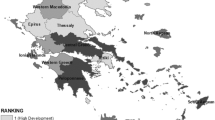Abstract
In this article we present a new proposal for the measurement of development, applied to the Pacific Countries of the African, Caribbean and Pacific Group (ACP), conditional on their insularity, and with privileged relations with the European Union. Our index has been constructed attending to the criteria defined in the Goals of the Millennium Declaration. For this purpose we will use the P2 distance method for the year 2007, the last year for which data are available. This index integrates socio-economic variables that permit a territorial ordering of the Pacific ACPs, in terms of those partial indicators.

Similar content being viewed by others
Notes
UNCTAD: TD/B/259.
This has occurred in the variables: Proportion of tuberculosis cases detected and cured under DOTS (Directly Observed Treatment Short Course); Proportion of population using an improved drinking water source; Proportion of population using an improved sanitation facility; average life expectancy at birth; total food supply; electricity consumption and the indicators of education, whose available information is from 2006, while for the Proportion of births attended by skilled health personnel we use that existing in 2004.
References
Bergson, A. (1938). A reformulation of certain aspects of welfare economics. Quarterly Journal of Economics, 52, 310–334.
Cobb, C., Halstead, T., & Rowe, J. (1995). The genuine progress indicator: Summary of data and methodology. San Francisco: Redefining Progress.
Cuenca, E., & Rodríguez, J. A. (2007). Evolution of expenditure in the budget of the European Union (1957–2002). European Planning Studies, 15(8), 1.113–1.126.
Dearden, J. H. (2008). EU aid policy towards the Pacific ACPs. Journal of International Development, 20(2), 205–217.
Escobar, L. (2006). Indicadores sintéticos de calidad ambiental: un modelo general para grandes zonas urbanas. EURE (Santiago), 32(96), 73–98.
Fundación “La CAIXA” (varios años), “Anuario Social de España”. Barcelona: Instituto Lawrence R. Klein, Universidad Autónoma de Madrid.
Ivanovic, B. (1974). Comment ètablir une liste des indicateurs de developpment. Revue de Statistique Apliquée, 22(2), 37–50.
Jasek-Rysdahl, K. (2001). Applying Sen’s capabilities framework to neighborhoods: Using local asset maps to deepen our understanding of well-being. Review of Social Economy, 49(3), 312–329.
Lasso de la Vega, M., & Urrutia, A. (1999). Aproximación a la medición del desarrollo humano de la contaminación medioambiental para las comunidades autónomas españolas. Actas de la XIII Reunión de Asepelt-España.
Li, E. (1999). An environmental cooperation agreement for the Asia-Pacific Region? The Australian Economic Review, 32(2), 145–156.
López, M. (2003). Bienestar socioeconómico de los municipios gallegos: una aproximación a su medida. Revista Galega de Economía, 12(2), 1–24.
Murias, P., Martínez, F., & Miguel, C. (2006). An economic well-being index for the spanish provinces. A data envelopment analysis approach. Social Indicators Research, 77(3), 395–417.
Noll, H.-H. (2002). Social indicators and quality of life research: Background, achievements and current trends. In Advances in Sociological Knowledge over Half a Century, N. Genov. París: International Social Sciencie Council.
OECD. (2002). Society at a glance: OECD social indicator. Paris: OECD.
Osberg, L., & Sharpe, A. (January 1999). An index of economic well-being for Canada and the United States. Paper presented at the annual meeting of the American Economic Association, New York.
Pena, J. B. (1977). Problemas de la medición del Bienestar y conceptos afines (Una aplicación del caso español). Madrid: I.N.E.
Pena, J. B. (2004). Desarrollo sostenible y bienestar social: una referencia a la Comunidad de Galicia. Revista Galega de Economía, 13, 1–16.
Pena, J. B. (2009). La medición del Bienestar social: una revisión crítica. Estudios de Economía aplicada, 27(2), 299–324.
Samuelson, P. (1956). Social indifference curves. Quarterly Journal of Economics, 70, 1–22.
Sánchez, M. A., & Rodríguez, N. (2003). El bienestar social en los municipios andaluces en 1999. Revista Asturiana de Economía, 27, 99–119.
Sen, A. (1991). Welfare, preference and freedom. Journal of Econometrics, 3, 15.
Somarriba, N., & López, A. (2000). Desarrollo humano y calidad de vida. Aproximación para las regiones españolas. Anales de Economía Aplicada. Oviedo: XIV Reunión de Asepelt.
Somarriba, N., & Pena, B. (2008). Aproximación a un indicador regional y nacional de los Objetivos de Lisboa a partir de la medida de distancia P2. Estudios Económicos de Desarrollo Internacional, 2, 83–94.
Somarriba, N., & Pena, B. (2009). Synthetic indicators of quality of life in Europe. Social Indicators Research, 96, 115–133.
United Nation. (2008). The millennium development goals report. New York: Oxford University Press.
United Nation Development Programme. (2005). Human development report. United Nations Development Program (UNDP). New York: Oxford University Press.
Veenhoven, R. (2000). The four qualities of life: Ordering concepts and measures of the good life. Official of Happiness Studies, 1, 1–39.
Veenhoven, R. (2009). Well-being in nations and well-being of nations. Social Indicators Research, 91(1), 5–21.
Vicéns, J., & Chasco, C. (2001). Estimación de un indicador de bienestar social de las provincias españolas. Barcelona: Documentos Sociales.
Zarzosa, P. (1994). El criterio de discriminación en la selección de indicadores de bienestar. Análisis del Coeficiente de Discriminación de Ivanovic. Estudios de Economía Aplicada, 2, 169–185.
Zarzosa, P. (1996). Aproximación a la medición del Bienestar Social. Valladolid: Secretariado de Publicaciones.
Author information
Authors and Affiliations
Corresponding author
Rights and permissions
About this article
Cite this article
Cuenca García, E., Rodríguez Martín, J.A. & Navarro Pabsdorf, M. The Features of Development in the Pacific Countries of the African, Caribbean and Pacific Group. Soc Indic Res 99, 469–485 (2010). https://doi.org/10.1007/s11205-010-9594-7
Accepted:
Published:
Issue Date:
DOI: https://doi.org/10.1007/s11205-010-9594-7



